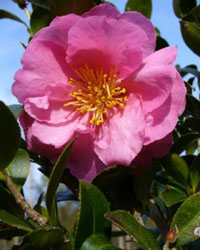Camellia sasanqua - Fall-blooming camellia



Family Theaceae
Description:
The genus Camellia includes the common Japanese camellia and the species that give us tea leaves and tea oil. Compared to the common Japanese camellia, the fall-blooming camellia has smaller leaves and flowers but produces many more flowers. Also, the fall-blooming camellia tolerates more sun and drier conditions. This flowering evergreen shrub is native to Japan where it has been cultivated for hundreds of years. Some scientists believe that the fall-blooming camellias of our gardens are the result of old hybrids of Camellia sasanqua and C. japonica. Today, hundreds of Camellia sasanqua cultivars and hybrids exist with flowers in shades of white, pink and red.
Location:
See plants at the southwest corner of building 8 (cultivar 'Bonanza'), the east side of building 12 ('Snow Flurry'), the east side of building 39 ('Shishi-Gashira'), and the southwest of building 50 ('Sparkling Burgandy.)
Size:
In the north Florida garden, expect a large shrub to about ten feet tall. Wild plants are known to be over thirty feet tall.
Care Instructions:
Light: full sun to part sun
Water: moderately drought tolerant when established, irrigation is beneficial
Soil: a well-drained, organic soil is best, low pH, acid fertilizer in spring or early summer may be beneficial
The fall-blooming camellia grows well in full sun in north Florida. Acidic, well-drained soils are best. Young plants in full sun may require supplemental irrigation until the plants are well established.
